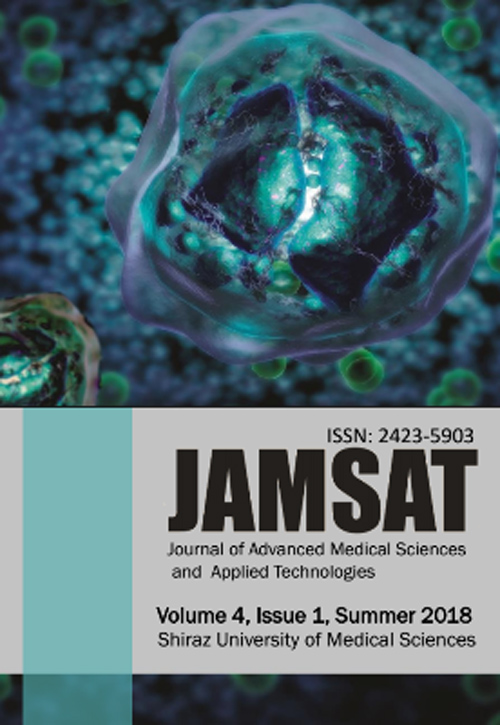فهرست مطالب

Journal of Advanced Medical Sciences and Applied Technologies
Volume:2 Issue: 4, Dec 2016
- تاریخ انتشار: 1395/09/11
- تعداد عناوین: 6
-
Pages 287-289Multiple sclerosis (MS) is a life-long condition with a wide and varied range of symptoms which can have a profound impact on all aspects of a patient’s life including future plans, self-confidence, self-esteem, relationships, quality of life and employment prospects. Living with MS can certainly be difficult and frustrating. Over time, however, most people find ways to adapt and come to terms with many of the changes that MS can bring and do manage to live fairly full lives.Keywords: Multiple sclerosis, Quality oflife, Neurocognitive burden, Social burden
-
Pages 291-298The current study aimed to define some factors contributing to implicit attitude formation mainly in the social interaction context. An agent-based computer simulation of a society including autonomous agents and an attitude object was used to track the implicit attitude progress towards the object. The society could simulate the autonomic behaviors. We provided a complex adaptive system and observed an emergent phenomenon as the formation and dynamics of implicit attitude in the society. Our results suggested that population size and the number of high-impact individuals are important for the formation of implicit attitude in a society. Moreover, when the number of factors affecting agents’ relationships increases, the dynamics of society tended to unpredictability. Our experience showed that diverse autonomous components of a society with implemented simple rules lead to emergent and seemingly organized system behavior, and the pattern of behavior can be affected by communication and environmental stress. Our study attempted to offer some key implications since few theories within the cognitive psychology and sociology have been stated in precise and unambiguous terms.Keywords: Implicit attitude formation, Social cognition simulation, Cognitive science
-
Pages 299-311Within the neuroscience and computational neuroscience communities, applications such as evaluating different cognitive responses of the brain, brain-computer interface (BCI) systems and brain connectivity studies have increasingly been using EEG phase information during the past few decades. The utility of EEG phase can be directly linked to the neural propagation and synchronized firing of neuronal populations during different cognitive states of the brain. Nevertheless, it has previously been shown that phase of narrow-band (frequency specific) foreground EEG (desired) is prone to contain fake spikes and variations (unrelated to brain activity) in the presence of background spontaneous EEG and low SNRs of foreground EEG (the low-amplitude analytic signals or LAAS problem). Accordingly, extracting the instantaneous EEG phase sequence for further utilization upon interpreting the cognitive states of the brain using phase related quantities, such as instantaneous frequency, phase shift, phase resetting and phase locking value, is a very sensitive and rigorous process. In this study, a simple procedure is proposed to illustrate the effects of LAAS problem on the utility of EEG phase related quantities in aforementioned applications, also to investigate the reliability of interpretations of the brain’s cognitive states based on such quantities. Results show that, without a proper and effective solution strategy, such potential flaws lead to incorrect physiological and pathological interpretations.Keywords: Cognitive state, Electroencephalogram phase, EEG Phase Synchronization, EEG Phase Desynchronization, Cognitive neuroscience
-
Pages 313-320In this study with the inspirations from both neuroscience and computer science, a combinatorial framework for object recognition was proposed having benefited from the advantages of both biologically-inspired HMAX_S architecture model for feature extraction and Extreme Learning Machine (ELM) as a classifier. HMAX model is a feed-forward hierarchical structure resembling the ventral pathway in the visual cortex of the brain and ELM is a powerful neural network, which randomly chooses hidden nodes and specifies analytically the single-hidden layer. ELM theories conjecture that this randomness may be true for biological learning in animal brains. It should be noted that the principle reason of using ELM is mainly as a result of its biological structure in order to imitate the biological object recognition system of mammalians and partly for its incredible speed which drastically lessens the runtime. Classification results are reported in Caltech101 dataset, at the focal point with its combinatorial framework serving considerable improvements over latest studies in both classification rate (96.39%) and the low runtime (0.417s).Keywords: Cortex-like model, Biologicalobject recognition, Biologicallyinspired neural network, HMAX, ELM
-
Pages 321-322Although many studies have highlighted the role of gamma-aminobutyric acid (GABA) in the pathophysiology of psychosis, there is no drug-induced animal model in which GABA is manipulated. In this article we propose a hypothetical animal model for psychosis based on the silencing GABAergic system. The presentation also suggest Pre-Pulse Inhibition test as a preferred approach towards proving this hypothesis.Keywords: Psychosis, GABA, Animalmodel
-
Pages 323-326The majority of patients with glioblastoma multiforme (GBM) suffer dismal outcomes. Adopting a broader, multi-mechanistic, multi-agent approach targeting GBM using readily available and fairly benign agents in combination with standard therapy may improve outcomes. Such agents include fluoxetine, fenofibrate, cimetidine, citrulline, valacyclovir, 1,3 1-6 beta glucan, and tadalafil, among others. In the context of in vitro and animal studies, these agents appear to target GBM cells and modify the tumor microenvironment. The current approach to GBM treatment focuses on limited molecular attributes of the condition. The following article highlights the relevance of the aforementioned agents in GBM treatment and proposes a multi-mechanistic, multi-agent paradigm shift, addressing a broader range of molecular attributes in the quest to improve patient outcomes.Keywords: Fluoxetine, Fenofibrate, Cimetidine, Citrulline, Valacyclovir, Tadalafil, Glioblastoma multiforme

